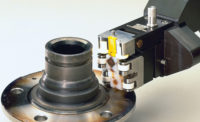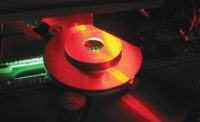Fast Flaw Detection

Ultrasonic flaw detection has been a valuable quality assurance tool for decades. Since the 1940s, inspectors have used the laws of physics that govern the propagation of sound waves through solid materials to detect hidden cracks, voids, porosity and other internal discontinuities in metals, composites, plastics and ceramics. High-frequency sound waves reflect from flaws in predictable ways, producing distinctive echo patterns that can be displayed and recorded by portable instruments. Ultrasonic testing is completely nondestructive and safe, and it is a well established test method in many basic manufacturing, process and service industries, particularly in applications involving welds and structural metals.

Ultrasonic inspection of an aircraft wing structure is shown here using a flaw detector with an angle beam transducer. Source: Olympus NDT
Basic Theory
Sound waves are simply organized mechanical vibrations traveling through a medium such as a solid, a liquid or a gas. Waves travel through a given material at a specific velocity, in a predictable direction, and when they encounter a boundary with a different medium, such as a crack in metal, they will be reflected. That physics principle is the basis of ultrasonic flaw detection.Ultrasonic testing is most commonly performed at frequencies in the range of 500 kilohertz to 20 megahertz, well above the limit of human hearing. Pulses of sound energy are generated by small probes called ultrasonic transducers which convert electrical pulses into short bursts of sound waves. The sound energy is coupled into the test piece, which it travels through until it encounters a boundary such as a far wall or a crack, at which point it reflects back to the transducer. The transducer converts the sound energy back into electrical energy, representing a wave pattern that is processed and displayed by the test instrument.
There are five types of ultrasonic transducers commonly used in flaw detection applications:
Sound waves in solids vibrate in various modes of propagation that are defined by the type of motion involved. Longitudinal waves and shear waves are the most common modes employed in ultrasonic flaw detection. Surface waves and plate waves also are used on occasion. A longitudinal or compressional wave is characterized by particle motion in the same direction as wave propagation, as from a piston source. Audible sound exists as longitudinal waves. A shear or transverse wave is characterized by particle motion perpendicular to the direction of wave propagation.

This is a representation of a typical angle beam sound path in a weld sample. Source: Olympus NDT
Ultrasonic Flaw Detectors
Modern ultrasonic flaw detectors are small, portable, microprocessor-based instruments suitable for both shop and field use. They generate and display an ultrasonic waveform that enables a trained operator to locate and categorize flaws in test pieces, often with the aid of analysis software. They typically include an ultrasonic pulser/receiver, hardware and software for signal capture and analysis, a waveform display, and a data logging module. Most contemporary instruments use digital signal processing for optimum stability and precision.Modern flaw detectors typically capture a waveform and then perform various measurement and analysis functions on it. An internal clock is used to synchronize transducer pulses and provide distance calibration. Signal processing may be as simple as generation of a waveform display that shows signal amplitude vs. time on a calibrated scale, or as complex as sophisticated digital processing algorithms that incorporate distance/amplitude correction and trigonometric calculations for angled sound paths. Alarm gates are often employed to monitor signal levels at selected points in the wave train to flag echoes from flaws.
The display may be a liquid crystal, an electroluminescent display or a cathode ray tube (CRT). The screen is normally calibrated in units of depth or distance. Multicolor displays can be used to provide interpretive assistance. Internal data loggers can be used to record full waveform and setup information associated with each test, if required for documentation purposes, or selected information such as echo amplitude, depth or distance readings, or presence or absence of alarm conditions.

This is a representation of a typical straight beam sound path in a test block. Source: Olympus NDT
Phased Array Systems
A special advanced category of portable ultrasonic flaw detectors is phased array systems, which use more complex hardware and software similar to that used in medical diagnostic imaging to provide a higher level of both test and interpretive capability. Instead of a single-element transducer, phased arrays use probes with a large number of elements, all individually pulsed and time-delayed. Ultrasonic beams are formed by constructive and destructive interference from these multiple sources. Unlike conventional instruments, phased array systems can electronically focus, steer and sweep the beam and then generate detailed cross-sectional images of the test piece.Procedure
Ultrasonic flaw detection is basically a comparative technique. Using appropriate reference standards along with a knowledge of sound wave propagation and generally accepted test procedures, a trained operator identifies the specific echo patterns that correspond to the echo responses from good parts and from representative flaws. The echo pattern from a test piece may then be compared to the patterns from these calibration standards to determine its condition.
This ultrasonic inspection of a pipe weld is done using a flaw detector with an angle beam transducer.
Source: Olympus NDT
Common Applications
Several common applications exist for the technology.Ultrasonic flaw detection is fast and reliable and can be applied to a vast range of metals, plastics, ceramics and composite parts. It can be a valuable tool both for verifying product quality and helping to ensure safety. NDT
Looking for a reprint of this article?
From high-res PDFs to custom plaques, order your copy today!







